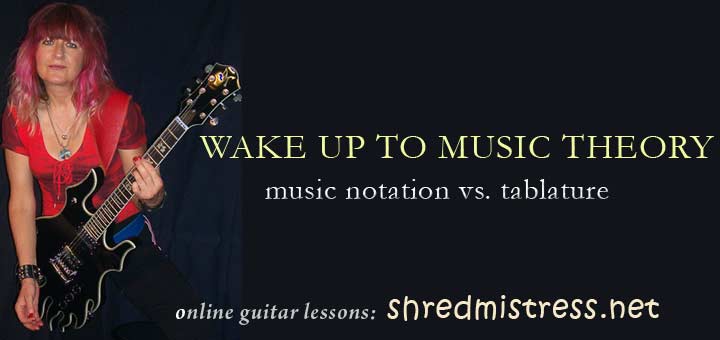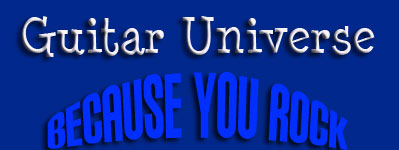
- Learning Music Notation opens up a World of Music.
- The Conventional Music Staff (5 horizontal lines): Notes are written ON the 5 lines and BETWEEN the 4 spaces available.
- Guitar Tablature (6 horizontal lines): Numbers, instead of notes, are written ON the 6 lines. The spaces are not used.
- Most of the time we count the lines (Notation and Tablature) from the bottom to the top.
So what about that Music Notation? Don’t we have Tablature?
Yes, we do and I’ll talk about Tablature first.
For starters, we guitar players have it made in many ways. We have Guitar Tablature and a fine invention it is indeed. Tablature, or Tab for short, was designed solely for guitarists and is an easy way to interpret chords and solos on the guitar. A real no-brainer, if you ask me. Useful and simple. More things in life outta be like that. However, the great debate rages on amongst musicians and guitar teachers, if tab is all that is needed these days for someone to become a good guitarist. First of all, notation and tablature are tools to help you interpret someone else’s songs and material. Or write down your own songs, for others to play. It’s part of a musician’s toolbox. Like technique, theory, scales, chord vocabulary, reading music is one of them.
Guitar Tablature works as follows:
Tab consists of 6 horizontal lines
(emulating the 6 strings of your guitar). On those lines you’ll find numbers.. either a succession of single numbers, or clusters of numbers (one atop another). The number(s) on the lines tell you WHERE on a given string a note or notes are to be played. A single number tells you to play a single note. A cluster of numbers tells you to play several notes at once (a chord for example). So, in a nutshell, a number 3 on the lowest line of the tablature instructs you to put a finger onto the 3. fret of the low E string. Simple enough.
When looking at sheet music,
you might see something like Example 2.1. Conventional Notation is at the top (with 5 lines) and Tablature sits at the bottom row, with 6 lines ( the 6 guitar strings really). This example, by the way, asks you to play one note at a time and, in this case, the Ionian Mode (to be explained later).
The 6 Tablature lines move from low line to high line
(low E string to high E string). Low tab line = Low E, highest tab line = High E. The remaining 4 lines equal the A, D, G and B strings. Tablature tells you EXACTLY on which string and which fret to place a finger, without having to read the notation above. Pretty nifty if you ask me.
Not everything is as simply laid out as in below Example 2.1. There is a lot more to it but to give someone who is not familiar with Tab an idea. (and lots of beginning guitarist don’t know about tab…).
Example 2.1 – Notation and Tablature staff
Given the ease of use of Guitar Tablature, you might wonder why we even bother with conventional notation. Well… there are many reasons why it is most beneficial to read and write notation. Read on.
Why Guitarists Should Learn and Respect Music Notation
- Tablature will isolate you from the rest of the music world, since only guitarists and bassists can apply this format.
- One HUGE drawback is the lack of rhythm in tablature. And you and I know, we are nothing without ‘da groove’. Sometimes we DO see some rhythm attached to the tab, but most of the time you will have to rely on the conventional notation above the tab to find out just how long each one of those ‘tab numbers’ are.
- You won’t learn the note names on your fretboard, chords and scales as proficiently as you would otherwise, unless you learn notation.
- Tab gives you only one option of how to use your fingers, when there are many more available.
- Lots of music is written for instruments outside of guitar i.e. piano, orchestras, or just song books that don’t necessarily cater to guitarists alone. You’ll loose out on a whole bunch of great music stuff.
- Last but not least… should you desire to become a ‘pro player’, like studio and session work, joining top acts as a guitar player, you MUST know more than tablature.
In the end, it depends on your personal ambition.
Embarking on a professional musicians career without knowing music theory incl. notation is like a surgeon in an operating room with only half a set of scalpels needed to rip the brain apart. Avail yourself of ALL the tools and you can be on your way to a music career that is successful and stays that way!
